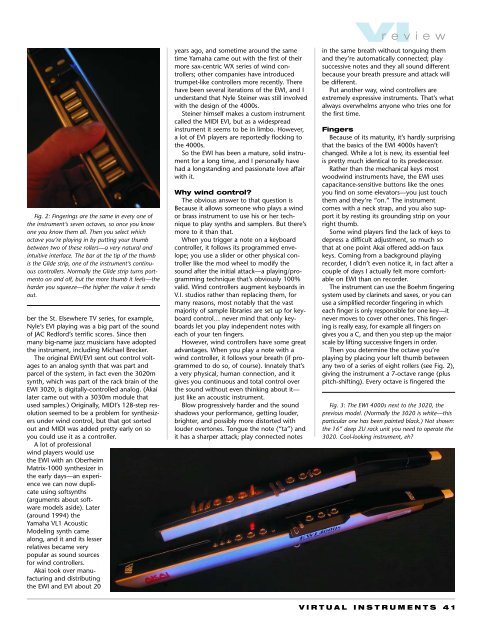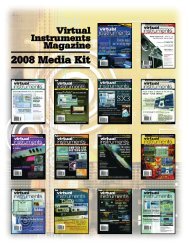Akai EWI 4000m Electric Wind Instrument Akai EWI 4000m Electric ...
Akai EWI 4000m Electric Wind Instrument Akai EWI 4000m Electric ...
Akai EWI 4000m Electric Wind Instrument Akai EWI 4000m Electric ...
Create successful ePaper yourself
Turn your PDF publications into a flip-book with our unique Google optimized e-Paper software.
Fig. 2: Fingerings are the same in every one of<br />
the instrument’s seven octaves, so once you know<br />
one you know them all. Then you select which<br />
octave you’re playing in by putting your thumb<br />
between two of these rollers—a very natural and<br />
intuitive interface. The bar at the tip of the thumb<br />
is the Glide strip, one of the instrument’s continuous<br />
controllers. Normally the Glide strip turns portmento<br />
on and off, but the more thumb it feels—the<br />
harder you squeeze—the higher the value it sends<br />
out.<br />
ber the St. Elsewhere TV series, for example,<br />
Nyle’s EVI playing was a big part of the sound<br />
of JAC Redford’s terrific scores. Since then<br />
many big-name jazz musicians have adopted<br />
the instrument, including Michael Brecker.<br />
The original <strong>EWI</strong>/EVI sent out control voltages<br />
to an analog synth that was part and<br />
parcel of the system, in fact even the 3020m<br />
synth, which was part of the rack brain of the<br />
<strong>EWI</strong> 3020, is digitally-controlled analog. (<strong>Akai</strong><br />
later came out with a 3030m module that<br />
used samples.) Originally, MIDI’s 128-step resolution<br />
seemed to be a problem for synthesizers<br />
under wind control, but that got sorted<br />
out and MIDI was added pretty early on so<br />
you could use it as a controller.<br />
A lot of professional<br />
wind players would use<br />
the <strong>EWI</strong> with an Oberheim<br />
Matrix-1000 synthesizer in<br />
the early days—an experience<br />
we can now duplicate<br />
using softsynths<br />
(arguments about software<br />
models aside). Later<br />
(around 1994) the<br />
Yamaha VL1 Acoustic<br />
Modeling synth came<br />
along, and it and its lesser<br />
relatives became very<br />
popular as sound sources<br />
for wind controllers.<br />
<strong>Akai</strong> took over manufacturing<br />
and distributing<br />
the <strong>EWI</strong> and EVI about 20<br />
years ago, and sometime around the same<br />
time Yamaha came out with the first of their<br />
more sax-centric WX series of wind controllers;<br />
other companies have introduced<br />
trumpet-like controllers more recently. There<br />
have been several iterations of the <strong>EWI</strong>, and I<br />
understand that Nyle Steiner was still involved<br />
with the design of the 4000s.<br />
Steiner himself makes a custom instrument<br />
called the MIDI EVI, but as a widespread<br />
instrument it seems to be in limbo. However,<br />
a lot of EVI players are reportedly flocking to<br />
the 4000s.<br />
So the <strong>EWI</strong> has been a mature, solid instrument<br />
for a long time, and I personally have<br />
had a longstanding and passionate love affair<br />
with it.<br />
Why wind control?<br />
The obvious answer to that question is<br />
Because it allows someone who plays a wind<br />
or brass instrument to use his or her technique<br />
to play synths and samplers. But there’s<br />
more to it than that.<br />
When you trigger a note on a keyboard<br />
controller, it follows its programmed envelope;<br />
you use a slider or other physical controller<br />
like the mod wheel to modify the<br />
sound after the initial attack—a playing/programming<br />
technique that’s obviously 100%<br />
valid. <strong>Wind</strong> controllers augment keyboards in<br />
V.I. studios rather than replacing them, for<br />
many reasons, most notably that the vast<br />
majority of sample libraries are set up for keyboard<br />
control… never mind that only keyboards<br />
let you play independent notes with<br />
each of your ten fingers.<br />
However, wind controllers have some great<br />
advantages. When you play a note with a<br />
wind controller, it follows your breath (if programmed<br />
to do so, of course). Innately that’s<br />
a very physical, human connection, and it<br />
gives you continuous and total control over<br />
the sound without even thinking about it—<br />
just like an acoustic instrument.<br />
Blow progressively harder and the sound<br />
shadows your performance, getting louder,<br />
brighter, and possibly more distorted with<br />
louder overtones. Tongue the note (“ta”) and<br />
it has a sharper attack; play connected notes<br />
VI<br />
review<br />
in the same breath without tonguing them<br />
and they’re automatically connected; play<br />
successive notes and they all sound different<br />
because your breath pressure and attack will<br />
be different.<br />
Put another way, wind controllers are<br />
extremely expressive instruments. That’s what<br />
always overwhelms anyone who tries one for<br />
the first time.<br />
Fingers<br />
Because of its maturity, it’s hardly surprising<br />
that the basics of the <strong>EWI</strong> 4000s haven’t<br />
changed. While a lot is new, its essential feel<br />
is pretty much identical to its predecessor.<br />
Rather than the mechanical keys most<br />
woodwind instruments have, the <strong>EWI</strong> uses<br />
capacitance-sensitive buttons like the ones<br />
you find on some elevators—you just touch<br />
them and they’re “on.” The instrument<br />
comes with a neck strap, and you also support<br />
it by resting its grounding strip on your<br />
right thumb.<br />
Some wind players find the lack of keys to<br />
depress a difficult adjustment, so much so<br />
that at one point <strong>Akai</strong> offered add-on faux<br />
keys. Coming from a background playing<br />
recorder, I didn’t even notice it, in fact after a<br />
couple of days I actually felt more comfortable<br />
on <strong>EWI</strong> than on recorder.<br />
The instrument can use the Boehm fingering<br />
system used by clarinets and saxes, or you can<br />
use a simplified recorder fingering in which<br />
each finger is only responsible for one key—it<br />
never moves to cover other ones. This fingering<br />
is really easy, for example all fingers on<br />
gives you a C, and then you step up the major<br />
scale by lifting successive fingers in order.<br />
Then you determine the octave you’re<br />
playing by placing your left thumb between<br />
any two of a series of eight rollers (see Fig. 2),<br />
giving the instrument a 7-octave range (plus<br />
pitch-shifting). Every octave is fingered the<br />
Fig. 3: The <strong>EWI</strong> 4000s next to the 3020, the<br />
previous model. (Normally the 3020 is white—this<br />
particular one has been painted black.) Not shown:<br />
the 16” deep 2U rack unit you need to operate the<br />
3020. Cool-looking instrument, eh?<br />
VIRTUAL INSTRUMENTS 41



